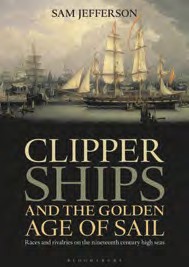Races and rivalries on the nineteenth century high seas

By Sam Jefferson
Published by Adlard Coles Nautical, an imprint of Bloomsbury Publishing 240 pages hardcover $45
Throughout the nineteenth century, shipping was the fastest means of intercontinental freight transport, and the fastest ships on the seas were clippers. Author Sam Jefferson, one of the foremost authorities on clipper ships, tells the story of how these magnificent vessels shaped worldwide commerce and culture.
In an era when ‘the sun never set on the British Empire,’ England’s rapidly growing demand for tea generated significant traffic along the sailing trade routes between the United Kingdom and its eastern colonies. Merchants and ship captains who could deliver their cargo first would prosper, and this in turn spurred shipwrights to build ever-faster vessels to meet the demand. Fierce rivalries ensued, culminating in the Great China Tea Race of 1866. Further fueling the Golden Age of Sail were the California Gold Rush and an increasing appetite for opium.
More than 200 illustration including paintings, drawings and rare archival photographs bring these ships and their captains and crews to life, as do newspaper reports, log entries, and firsthand accounts of monsoon-driven races. Supplanted by steamships, the Golden Age of Sail was waning by 1900 and gone by World War II. “We should all feel the death of commercial sail,” the author writes, “for with the passing of these great ships, the oceans have lost something beautiful, something that transcended mere function.”
Sam Jefferson was captivated by clipper ships from a very young age. Formerly Deputy Editor of Sailing Today, he lives on a boat and divides his time between writing and contributing to magazines including Classic Boat, Sailing Today, and Traditional Boats and Tall Ships, and working as a skipper for a number of charter companies. To order Clipper Ships and the Golden Age of Sail and many more excellent maritime books in the Adlard Coles Nautical catalog, visit adlardcoles.com.




